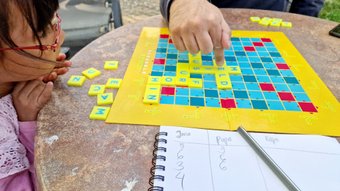Song cover of "Ojo dipleroki", a traditional javanese song by Little Kobold
19
About :
English
Hello dear Hive-bloggers... here we come again with a new song for you to enjoy...
This is another masterpiece of Ki Dhalang Narto Sabdo, the legendary puppet master of Java-Indonesia: "Ojo di pleroki".
The song is roughly telling about a young lady and a gentleman flirting subtly with each other.
Furthermore reminding the young generation to not forget their traditional proper upbringing despite trying to follow the development and adjusting to modern values.
Everything in the world are changing indeed but they are all in fact part of the "culture".
For someone who is born and growing up in Eurepe, our little girl's javanese pronunciation is considered excellent, only the "r" still vibrates rather strongly :-D.
My family members in Indonesia are all very excited to know that she can sing the song very well.
She reached all the tone perfectly and now she can even follow the music tempo rather well.
This video consists of two clips. The first one is the duett of mommy and little kobold where the mommy sung the lady's part and the little princess was singing the male's part.
It's somehow cute that she tried to imitate the male's deep tone LOL.
The second clip was her duett with an "uncle", so here she is singing the female's part of the song.
Anyway you can watch the original performance of the song here:
Deutsch
Hallo liebe Hive-Blogger... hier kommen wir wieder mit einem neuen Lied für euch...
Dies ist ein weiteres Meisterwerk von Ki Dhalang Narto Sabdo, dem legendären Puppenspieler von Java-Indonesien: "Ojo di pleroki".
Das Lied erzählt grob von einer jungen Dame und einem Herrn, die subtil miteinander flirten.
Außerdem wird die junge Generation daran erinnert, ihre traditionelle Erziehung nicht zu vergessen, auch wenn sie versuchen, der Entwicklung zu folgen und sich den modernen Werten anzupassen.
Alles in der Welt verändert sich zwar, aber sie sind doch eigentlich einfach nur Teil der "Kultur".
Für jemanden, der in Europa geboren und aufgewachsen ist, gilt die javanische Aussprache unseres kleinen Mädchens als ausgezeichnet..., nur das "r" vibriert noch ziemlich stark :-D.
Meine Familienmitglieder in Indonesien sind alle sehr begeistert, dass sie das Lied sehr gut singen kann.
Sie hat alle Töne perfekt getroffen und kann jetzt sogar das Tempo der Musik recht gut folgen.
Dieses Video besteht aus zwei Clips. Der erste ist das Duett von Mama und dem kleinen Kobold, bei dem die Mama den weiblichen Part und die kleine Prinzessin den männlichen Part singt.
Es ist irgendwie niedlich, dass sie versucht hat, den tiefen Ton eines Mannes zu imitieren LOL.
Der zweite Clip war ihr Duett mit einem "Onkel", hier singt sie also den weiblichen Teil des Liedes.
Wie auch immer, ihr könnt euch übrigens die Original-Performance des Liedes hier ansehen:
English
Actually there are many versions of the professional remake of this song, because this traditional piece was really one of the most popular masterpiece of the deceased Narto Sabdo.
However the one in the video above was one of the version performed with the traditional javanese instruments, called Gamelan which uses a pentatonic scale and where the performers are also wearing our traditional costumes: Kebaya and Kain Batik.
With this reference video you can evaluate the performance of our little girl, whether she is performing well enough or not ;-)
Ok everyone, that's it for now and thanks for watching and giving your support.
Deutsch
Eigentlich gibt es viele Versionen des professionellen Remakes dieses Liedes, denn dieses traditionelle Stück war wirklich eines der beliebtesten Meisterwerke des verstorbenen Narto Sabdo.
Die Version im obigen Video wurde jedoch mit den traditionellen javanischen Instrumenten, Gamelan genannt, gespielt, die eine pentatonische Tonleiter verwenden und bei denen die Interpreten auch unsere traditionellen Kostüme tragen: Kebaya und Kain Batik.
Das gefällt mir halt am besten.
Mit diesem Referenzvideo könnt ihr die Leistung unseres kleinen Mädchens beurteilen, ob sie gut genug ist oder nicht ;-)
So, das war's für heute und vielen Dank fürs Zuschauen und Unterstützen.
Tags :
Their limit for today is $0!






























Comments:
Reply:
To comment on this video please connect a HIVE account to your profile: Connect HIVE Account